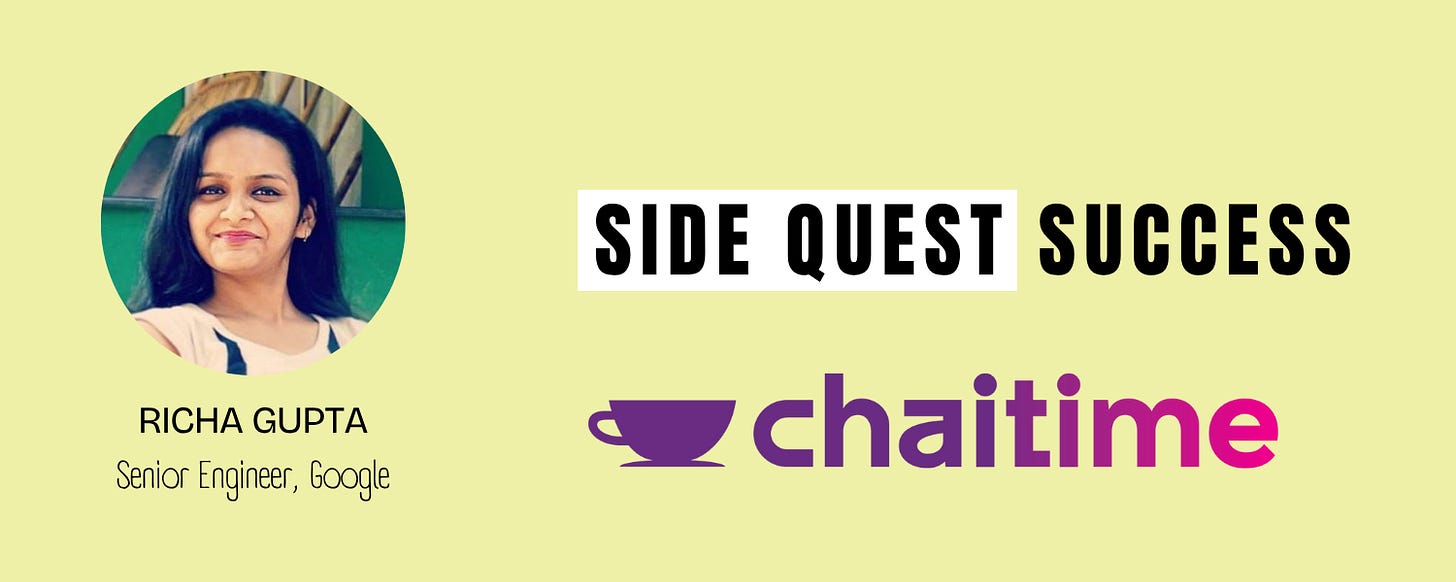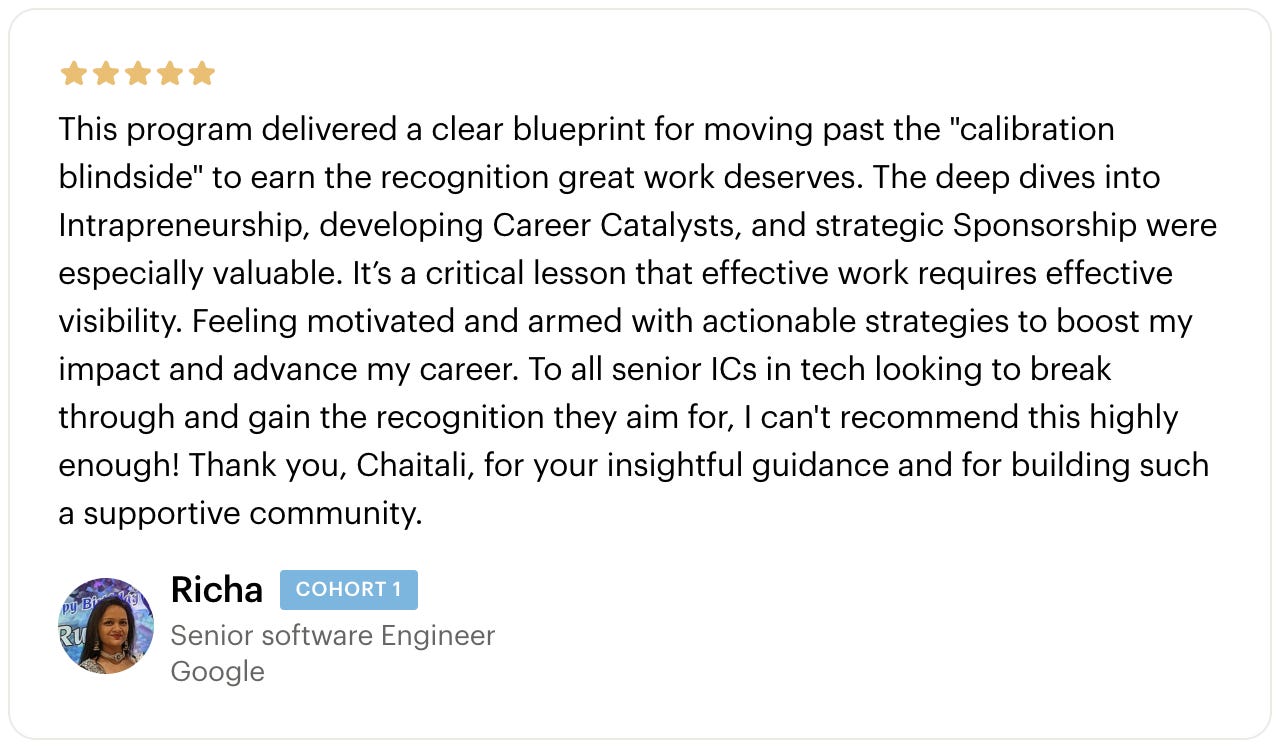Sparking Intrapreneurship: Side Quest Success
Hello folks!
If you follow me on LinkedIn or have taken my course, you’d have heard me talk about Intrapreneurship - a style of leadership that I encourage big/mid-tech ICs to embrace. In this series, ChaiTime periodically hosts Intrapreneurs to talk about various aspects of their journey.
Today, my guest is Richa Gupta. Richa is a senior engineer at Google and regularly posts excellent perspectives and tips on LinkedIn related to interviewing and growth in big tech companies. Follow her if you are actively seeking opportunities in these companies!
Richa is an alumni of my course and she first shared her Side Quest success story in one of our live sessions during the course. It was so inspiring that I requested her to share it here on ChaiTime as well! So over to Richa to share how a side quest got her promoted!
Have you ever noticed something broken in your organization—a process, a tool, a knowledge gap—and thought, “Someone should really fix that”? We’ve all been there. But what happens when you decide that someone is you?
The Uncharted Path: When a Waiting List Becomes an Opportunity
It all started for me with a waiting list, but it ended up transforming my career trajectory.
Our industry was being reshaped by a tidal wave of AI, ML, and LLMs. As a ML engineer, I found myself in the eye of this storm. The demand for AI literacy was skyrocketing, and Google offered world-class internal crash courses in Machine Learning – true goldmines of knowledge. However, in our APAC region, supply was completely overwhelmed by demand. Talented, eager colleagues were stuck on endless waiting lists, seeing upskilling opportunities disappear as soon as they arose.
This wasn't my assigned problem to solve. It wasn't on my list of goals or key results. But watching our collective ability to innovate get throttled was a problem I couldn't ignore. I decided to embark on a "side quest."
From Observation to Ownership: The Quest Begins
My first step was to prove the need was real. I launched a detailed survey, not just asking if people wanted training, but what specific ML topics would supercharge their work. The response was overwhelming and gave me a crystal-clear mandate.
Armed with this data, I became a community builder. I reached into my network and found a coalition of the willing—fellow ML experts who shared my passion for teaching. Tapping into that classic Google spirit of collaboration, we decided to build our own solution.
Together, we planned and facilitated a full-fledged ML crash course tailored specifically for our organization. The experience was exhilarating. Seeing the "aha!" moments light up my colleagues' faces and facilitating vibrant discussions was its own reward. Afterwards, I kept the momentum going with recap emails, curated resources, and feedback surveys to make the next one even better.
Scaling the Impact: Beyond Engineers to Empowering Leaders
The success of that first course was thrilling, but I soon realized we had only solved part of the equation. For innovation to truly flourish, managers and leaders needed to speak the language of ML. They were the ones who approved projects, allocated resources, and set strategic direction. They needed to understand the potential and limitations of AI to effectively lead their teams into the future.
This realization sparked the next phase of my side quest. I began facilitating a new set of courses: "ML for Managers and Leaders." These weren't just watered-down technical trainings; they were strategic sessions focused on team-building, project evaluation, and fostering an innovative culture around AI.
The impact was immediate and spread quickly. Word got out, and soon, requests were coming in from other organizations across Google. What started as a small initiative for my own team grew into a cross-organizational effort. I found myself facilitating these sessions for numerous teams, dramatically expanding my network and visibility far beyond my day-to-day role.
The Unforeseen Payoff: Career Momentum When It Mattered Most
Then came the plot twist: a major re-organization.
Just as my promotion packet was being submitted, my manager and reporting line changed. Though my previous and current managers strongly supported me, a new manager who was unfamiliar with my work now had to champion my case to a committee of executives from an organization I had only just formally joined. It was a scenario that, despite strong direct support, could still stall any career.
But my side quest had given me a powerful, unforeseen advantage.
As my case was presented, it turned out that several key members of that promotion committee had personally seen the impact of the ML training. They had either attended a leadership session themselves or had managers on their teams who had. My name wasn't just a line item in a promotion packet; it was connected to a high-impact initiative they already knew and valued. This pre-existing goodwill, this reputation I had built, completely smoothed my path.
The Side Quest Blueprint: Lessons for Your Own Career
This journey reinforced several invaluable lessons that have become my personal career blueprint:
Lead Through Action, Not Title: You don't need formal authority to make a difference. Identifying a pressing need and rallying people to solve it is the most authentic form of leadership.
Solve the Problems You See, Not Just the Ones You're Given: The most impactful work often lies just outside your defined responsibilities. Demonstrating that you see the bigger picture is a hallmark of a true owner.
Attract Powerful Sponsors by Delivering Strategic Value: I didn't have to seek out sponsors; the project brought them to me. When you train managers and directors, you aren't just sharing knowledge; you're demonstrating your strategic value directly to the people who make sponsorship and promotion decisions. They become your champions because they've seen your impact firsthand.
Build Your Network Through Generosity: My network grew not because I was asking for something, but because we were collectively giving something of value. This creates robust, trust-based relationships that are far more powerful than transactional connections.
Visibility is Gold, and Reputation is Your Unseen Advocate: The positive reputation I built acted as my advocate when I needed it most. It provided a layer of resilience during a challenging career transition and spoke for me in rooms I wasn't even in.
Conclusion: Find Your Uncharted Path
Side quests can feel like extra work, but they’re often the most direct route to deep learning, broad impact, and career acceleration. Look around: what bottleneck or unmet need exists in your context? That “waiting list” might be your gateway to making a difference—and to being recognized for it. Start small, validate quickly, rally collaborators, and share results widely. Your next great adventure—and the growth that follows—may be hiding just beyond your job description.
Is It Time for Your Side Quest? A Quick Checklist
Do you repeatedly hear colleagues complain about the same roadblock?
Is there a skill gap on your team that everyone acknowledges but no one is addressing?
Have you identified a broken process that you have a clear idea on how to fix?
Are you passionate about a topic that could benefit others?
If you answered "yes" to any of these, you might have found your opportunity.
"Your biggest career opportunities often lie in solving the problems that aren't officially your job. Find a gap, gather allies, and build something. The impact will follow.
Richa - thanks for sharing your thoughts on how to find high-impact good ideas!
Readers - if you enjoyed this article, be sure to follow Richa on LinkedIn for more such thoughtful posts. Here is my article on Side Quests as well to encourage you to think of them as a career growth tool.
Lastly, here is Richa’s review of my course. If you are looking to understand and use more such career catalysts in your career growth, enroll for the upcoming cohort soon!




